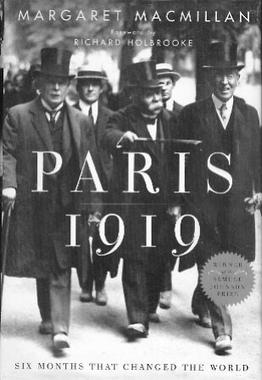 Paris 1919: Six Months That Changed the World by Margaret MacMillan (Random House, 2002, 608 pages)
Paris 1919: Six Months That Changed the World by Margaret MacMillan (Random House, 2002, 608 pages)If you're looking for an exquisitely detailed and well-researched book about the debacle that was the Paris Peace Conference ending World War I, then this is most certainly your book.
I should say here, if you didn't already know, that I am a bit obsessed with history. Love reading it, love talking about it, love watching documentaries, etc. etc. So while MacMillan doesn't necessarily grab you by the collar and whisk you off into a colorful and crazy place where you stay up all night just wanting to read a little bit more...that's ok. 'Cause if you're a history buff, you'll plow through the book on your own momentum, carried along by MacMillan's crystal-clear prose. No wonder this book won the Samuel Johnson Prize, among a BUNCH of others.
What really makes this book a must-read is its careful and thorough discussion of all of the competing claims, counter-claims, nationalist arguments, and territorial demands that turned the conference into a messy disaster. Despite the fact that representatives from many nations attended, it all came down to the "Big Three": Wilson, Lloyd George, and Clemenceau. It was to Wilson that people around the world looked at this point for hope, since the "Fourteen Points" he had proclaimed before the conference promised that "self-determination" would guide the Allies's hands in redrawing borders. Many understood this to mean that they would be able to throw off the yoke of foreign governments and establish their own, more homogeneous, nations. Reality was a whole other story. Not only were clashing ethnic groups thrown together in new countries like Iraq, and central Europe thrown into confusion with ethnic groups split by new borders, but Germany was dealt a harsh hand, the humiliation of which led to the rise of fascism there and, ultimately, World War II.
MacMillan spends entire chapters on specific countries/empires, tracing back territorial claims and discussing the representatives' aims and efforts with the Big Three at the conference. What we come away with is a picture of leaders who claimed that they were working toward a "lasting peace," but who ultimately fell back onto the old system of carving up countries and doling out mandates to suit their ultimate economic interests. After all, as this book shows, Wilson, Lloyd George, Clemenceau, and the other leaders were only human, and the utopia they had claimed they were working toward was just too difficult to reach.
No comments:
Post a Comment